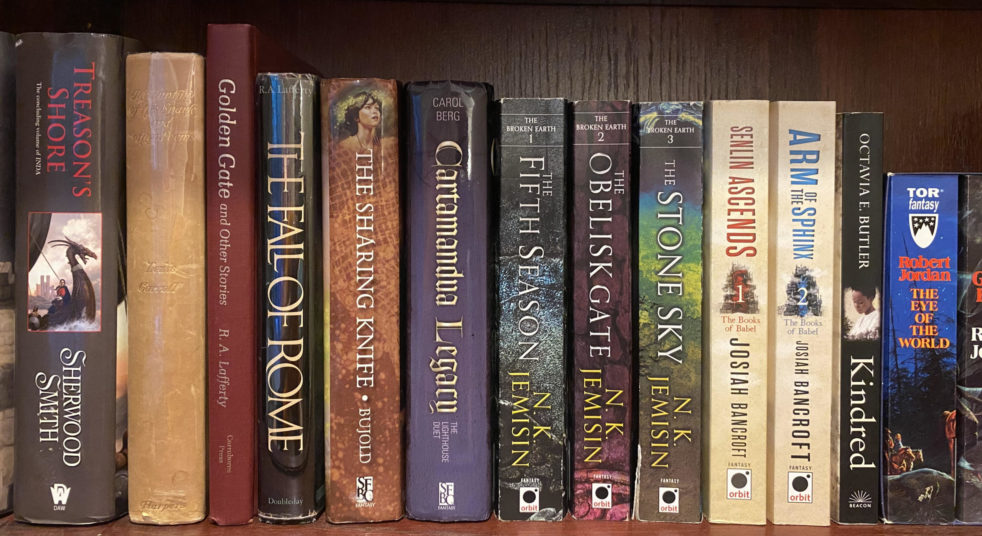
This review is based on an eARC (Advance Reading Copy) provided by the publisher via NetGalley in exchange for an honest review. Where the Axe is Buried was released on April 1, 2025.
I started reading Ray Nayler a couple years ago, and I’ve been consistently impressed with his quiet explorations of how big political and technological shifts affect ordinary people on the ground. His debut novel, The Mountain in the Sea, was one of my favorite books of the year in 2022, so I jumped at the chance to read his second book, the standalone Where the Axe is Buried.
Where the Axe is Buried follows a variety of perspectives across an almost-recognizable future Europe, most heavily coalescing around a fascist Federation never named but clearly heavily inspired by Russia. If the book has a main character, it’s a budding genius shackled with heavily restricted movement after returning home from studies in London to visit her ailing father. But we also see through the eyes of her father, of a famous dissident living out her final years in isolation, of the functionally immortal President who simply finds a new body whenever one begins to wear out, and of the scientist who helps him through the transitions. Outside the Federation, the lands to the West are ruled by AI Prime Ministers, tasked to allocate resources algorithmically, heading off criticism even while calcifying inequality. But with the exception of one government staffer in a country facing riots at the decisions of the newly-installed PM, the Western perspectives all have an eye cast toward the imprisoned lead, some hoping to get her back to London and others just wanting a piece of her newest invention.
Clearly, there’s a lot going on, and perhaps the biggest weakness of the novel is the difficulty summarizing exactly what it’s about. In a lot of ways—and in very Nayler fashion—it’s an exploratory novel, interested in people living under oppressive regimes that aren’t amenable to change, whether those regimes be AI-led or something more garden-variety fascist. And the dominant mood coming from those people is a sort of guilty ennui, whether stemming from past failures to effect change, fear of the consequences of trying, or simply lack of direction and motivation. It’s a thematically powerful look at the way people can see their countries slip away from them, without anything they can do to prevent it. But while it serves as perhaps the most memorable theme, it isn’t the main thrust of the plot. Because, mostly through circumstances changing around them, the bulk of the perspective characters do find themselves ultimately spurred to action. And while the shape of that action takes a long time to come into focus, it’s ultimately aimed at cataclysmic shifts, both in the Federation and the West.
I wouldn’t expect Nayler to write a book where a revolution neatly solves all of society’s problems, and that’s certainly not what we see here. Where the Axe is Buried never ceases to be a deeply messy novel, with the majority of the perspective characters coming from outside the power structure and left mostly in the dark about the big changes happening around them. This is a deeply human book about people acting in ignorance and hoping for the best. It’s full of chaos and uncertainty, both about what is happening and about whether what’s happening is good or bad. And thematically, I love it.
But it also is a book about creating these seismic shifts, and here the slow-developing, often obfuscated nature of the plot keeps it from building the kind of emotional impact one expects from such tales. I can think of one scene with a revelation I found absolutely stunning—even despite having noticed hints in that direction. But with so many characters who are primarily reactive, a lot of what happens just happens. Even without closure on the big changes, there are plenty of small successes or tragedies that didn’t hit me quite as hard as would have been justified by the events themselves. There being so much going on serves the themes wonderfully, but the book loses a bit of sharpness in the individual scenes.
On the whole, Where the Axe is Buried is a book that I love for the themes. The mood is expertly delivered, as is the social commentary in a couple starkly different cultures, and the ambiguity of the conclusion is perfect. But while there were flashes of excellent plot, there were also some major events in the lives of the characters that didn’t come through quite as sharply as they could have. It’s very much the sort of novel that I’d expect from Nayler, and it’s an easy one to recommend to fans of his previous work. It’s not one that quite hits the sky-high bar of The Mountain in the Sea, but it remains very good.
Recommended if you like: meditative stories, revolutionary themes.
Can I use it for Bingo? It fits Down with the System, A Book in Parts, and Published in 2025. Depending on how you feel about downloading consciousness into different bodies, you could make an argument for Biopunk.
Overall rating: 16 of Tar Vol’s 20. Four stars on Goodreads.
